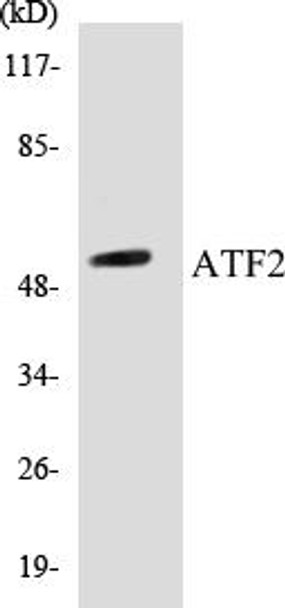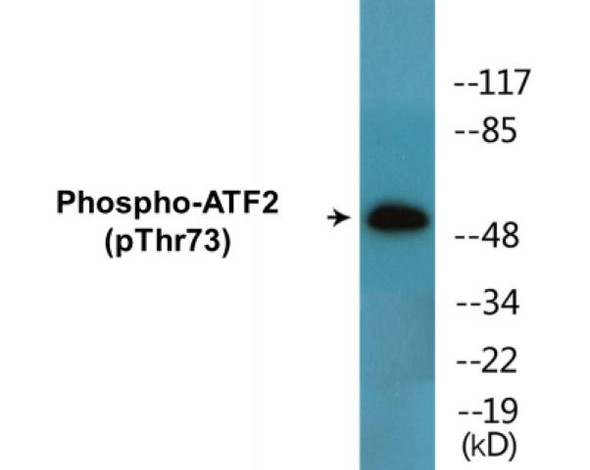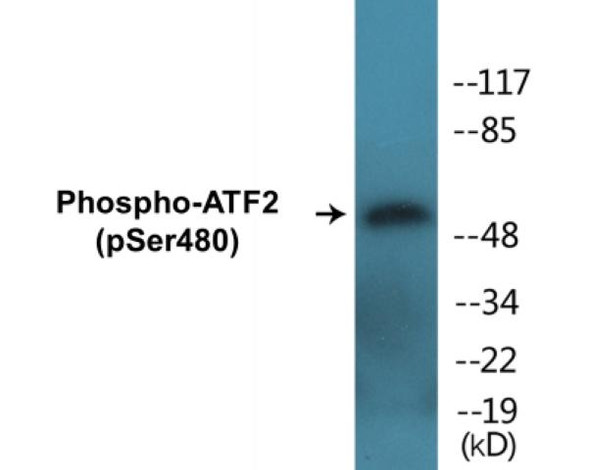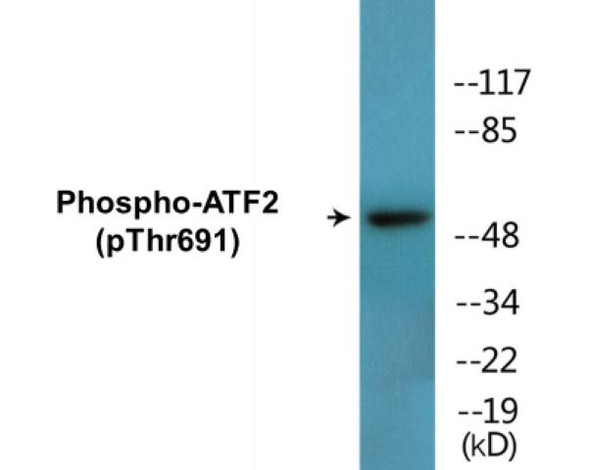ATF2 Colorimetric Cell-Based ELISA Kit (CBCAB00535)
- SKU:
- CBCAB00535
- Product Type:
- ELISA Kit
- ELISA Type:
- Cell Based
- Research Area:
- Epigenetics and Nuclear Signaling
- Reactivity:
- Human
- Mouse
- Rat
- Detection Method:
- Colorimetric
Description
ATF2 Colorimetric Cell-Based ELISA Kit
The ATF2 (Activating Transcription Factor 2) Colorimetric Cell-Based ELISA Kit is a powerful tool for detecting and quantifying ATF2 levels in cell lysates or tissue homogenates. This kit utilizes a colorimetric detection method for the accurate measurement of ATF2, a transcription factor that plays a key role in cellular responses to stress and growth factor signaling.With its high sensitivity and specificity, the ATF2 Colorimetric Cell-Based ELISA Kit provides reliable and reproducible results, making it an essential tool for researchers studying signaling pathways, gene expression, and stress responses in a variety of cell types.
By measuring ATF2 levels, researchers can gain valuable insights into the molecular mechanisms underlying various diseases, including cancer, neurodegenerative disorders, and autoimmune diseases.Overall, the ATF2 Colorimetric Cell-Based ELISA Kit is a valuable asset for research labs looking to investigate the role of ATF2 in cellular signaling pathways and disease progression. With its easy-to-use protocol and high performance, this kit is ideal for a wide range of applications in cell biology, pharmacology, and disease research.
| Product Name: | ATF2 Colorimetric Cell-Based ELISA |
| Product Code: | CBCAB00535 |
| ELISA Type: | Cell-Based |
| Target: | ATF2 |
| Reactivity: | Human, Mouse, Rat |
| Dynamic Range: | > 5000 Cells |
| Detection Method: | Colorimetric 450 nmStorage/Stability:4°C/6 Months |
| Format: | 96-Well Microplate |
The ATF2 Colorimetric Cell-Based ELISA Kit is a convenient, lysate-free, high throughput and sensitive assay kit that can detect ATF2 protein expression profile in cells. The kit can be used for measuring the relative amounts of ATF2 in cultured cells as well as screening for the effects that various treatments, inhibitors (ie siRNA or chemicals), or activators have on ATF2.
Qualitative determination of ATF2 concentration is achieved by an indirect ELISA format. In essence, ATF2 is captured by ATF2-specific primary antibodies while the HRP-conjugated secondary antibodies bind the Fc region of the primary antibody. Through this binding, the HRP enzyme conjugated to the secondary antibody can catalyze a colorimetric reaction upon substrate addition. Due to the qualitative nature of the Cell-Based ELISA, multiple normalization methods are needed:
| 1. | A monoclonal antibody specific for human GAPDH is included to serve as an internal positive control in normalizing the target absorbance values. |
| 2. | Following the colorimetric measurement of HRP activity via substrate addition, the Crystal Violet whole-cell staining method may be used to determine cell density. After staining, the results can be analysed by normalizing the absorbance values to cell amounts, by which the plating difference can be adjusted. |
| Database Information: | Gene ID: 1386, UniProt ID: P15336, OMIM: 123811, Unigene: Hs.592510 |
| Gene Symbol: | ATF2 |
| Sub Type: | None |
| UniProt Protein Function: | ATF-2: a transcription factor that is a member of the leucine zipper family. Binds to the cAMP-responsive element (CRE). Forms a homodimer or heterodimer with c-Jun and stimulates CRE-dependent transcription. Also possesses histone acetyltransferase (HAT) activity that specifically acetylates histones H2B and H4 in vitro. |
| UniProt Protein Details: | Protein type:EC 2.3.1.48; Transcription factor; C2H2-type zinc finger protein Chromosomal Location of Human Ortholog: 2q32 Cellular Component: nucleoplasm; mitochondrial outer membrane; cytoplasm; nucleus Molecular Function:RNA polymerase II transcription factor activity, enhancer binding; protein binding; histone acetyltransferase activity; protein heterodimerization activity; metal ion binding; cAMP response element binding protein binding; transcription coactivator activity; chromatin binding; transcription factor activity; protein kinase binding Biological Process: fat cell differentiation; transcription from RNA polymerase II promoter; establishment and/or maintenance of chromatin architecture; MyD88-independent toll-like receptor signaling pathway; stress-activated MAPK cascade; toll-like receptor 3 signaling pathway; positive regulation of transforming growth factor-beta2 production; response to osmotic stress; toll-like receptor 2 signaling pathway; toll-like receptor 10 signaling pathway; MyD88-dependent toll-like receptor signaling pathway; toll-like receptor 5 signaling pathway; regulation of transcription from RNA polymerase II promoter; regulation of transcription, DNA-dependent; regulation of transcription factor activity; intra-S DNA damage checkpoint; toll-like receptor signaling pathway; innate immune response; positive regulation of transcription from RNA polymerase II promoter; positive regulation of transcription factor activity; histone acetylation; toll-like receptor 9 signaling pathway; response to DNA damage stimulus; toll-like receptor 4 signaling pathway |
| NCBI Summary: | This gene encodes a transcription factor that is a member of the leucine zipper family of DNA binding proteins. The encoded protein has been identified as a moonlighting protein based on its ability to perform mechanistically distinct functions This protein binds to the cAMP-responsive element (CRE), an octameric palindrome. It forms a homodimer or a heterodimer with c-Jun and stimulates CRE-dependent transcription. This protein is also a histone acetyltransferase (HAT) that specifically acetylates histones H2B and H4 in vitro; thus it may represent a class of sequence-specific factors that activate transcription by direct effects on chromatin components. The encoded protein may also be involved in cell's DNA damage response independent of its role in transcriptional regulation. Several alternatively spliced transcript variants have been found for this gene [provided by RefSeq, Jan 2014] |
| UniProt Code: | P15336 |
| NCBI GenInfo Identifier: | 215274241 |
| NCBI Gene ID: | 1386 |
| NCBI Accession: | P15336.4 |
| UniProt Secondary Accession: | P15336,Q13000, Q3B7B7, Q4ZFU9, Q53RY2, Q8TAR1, A1L3Z2 A4D7U4, A4D7U5, A4D7V1, D3DPE9, G8JLM5, |
| UniProt Related Accession: | P15336 |
| Molecular Weight: | 505 |
| NCBI Full Name: | Cyclic AMP-dependent transcription factor ATF-2 |
| NCBI Synonym Full Names: | activating transcription factor 2 |
| NCBI Official Symbol: | ATF2 |
| NCBI Official Synonym Symbols: | HB16; CREB2; TREB7; CREB-2; CRE-BP1 |
| NCBI Protein Information: | cyclic AMP-dependent transcription factor ATF-2; histone acetyltransferase ATF2; cAMP-dependent transcription factor ATF-2; cAMP-responsive element-binding protein 2; cAMP response element-binding protein CRE-BP1; cyclic AMP-responsive element-binding protein 2; cAMP responsive element binding protein 2, formerly; activating transcription factor 2 splice variant ATF2-var2 |
| UniProt Protein Name: | Cyclic AMP-dependent transcription factor ATF-2 |
| UniProt Synonym Protein Names: | Activating transcription factor 2; Cyclic AMP-responsive element-binding protein 2; CREB-2; cAMP-responsive element-binding protein 2; HB16; Histone acetyltransferase ATF2; cAMP response element-binding protein CRE-BP1 |
| Protein Family: | Alcohol O-acetyltransferase |
| UniProt Gene Name: | ATF2 |
| UniProt Entry Name: | ATF2_HUMAN |
| Component | Quantity |
| 96-Well Cell Culture Clear-Bottom Microplate | 2 plates |
| 10X TBS | 24 mL |
| Quenching Buffer | 24 mL |
| Blocking Buffer | 50 mL |
| 15X Wash Buffer | 50 mL |
| Primary Antibody Diluent | 12 mL |
| 100x Anti-Phospho Target Antibody | 60 µL |
| 100x Anti-Target Antibody | 60 µL |
| Anti-GAPDH Antibody | 60 µL |
| HRP-Conjugated Anti-Rabbit IgG Antibody | 12 mL |
| HRP-Conjugated Anti-Mouse IgG Antibody | 12 mL |
| SDS Solution | 12 mL |
| Stop Solution | 24 mL |
| Ready-to-Use Substrate | 12 mL |
| Crystal Violet Solution | 12 mL |
| Adhesive Plate Seals | 2 seals |
The following materials and/or equipment are NOT provided in this kit but are necessary to successfully conduct the experiment:
- Microplate reader able to measure absorbance at 450 nm and/or 595 nm for Crystal Violet Cell Staining (Optional)
- Micropipettes with capability of measuring volumes ranging from 1 µL to 1 ml
- 37% formaldehyde (Sigma Cat# F-8775) or formaldehyde from other sources
- Squirt bottle, manifold dispenser, multichannel pipette reservoir or automated microplate washer
- Graph paper or computer software capable of generating or displaying logarithmic functions
- Absorbent papers or vacuum aspirator
- Test tubes or microfuge tubes capable of storing ≥1 ml
- Poly-L-Lysine (Sigma Cat# P4832 for suspension cells)
- Orbital shaker (optional)
- Deionized or sterile water
*Note: Protocols are specific to each batch/lot. For the correct instructions please follow the protocol included in your kit.
| Step | Procedure |
| 1. | Seed 200 µL of 20,000 adherent cells in culture medium in each well of a 96-well plate. The plates included in the kit are sterile and treated for cell culture. For suspension cells and loosely attached cells, coat the plates with 100 µL of 10 µg/ml Poly-L-Lysine (not included) to each well of a 96-well plate for 30 minutes at 37°C prior to adding cells. |
| 2. | Incubate the cells for overnight at 37°C, 5% CO2. |
| 3. | Treat the cells as desired. |
| 4. | Remove the cell culture medium and rinse with 200 µL of 1x TBS, twice. |
| 5. | Fix the cells by incubating with 100 µL of Fixing Solution for 20 minutes at room temperature. The 4% formaldehyde is used for adherent cells and 8% formaldehyde is used for suspension cells and loosely attached cells. |
| 6. | Remove the Fixing Solution and wash the plate 3 times with 200 µL 1x Wash Buffer for five minutes each time with gentle shaking on the orbital shaker. The plate can be stored at 4°C for a week. |
| 7. | Add 100 µL of Quenching Buffer and incubate for 20 minutes at room temperature. |
| 8. | Wash the plate 3 times with 1x Wash Buffer for 5 minutes each time. |
| 9. | Add 200 µL of Blocking Buffer and incubate for 1 hour at room temperature. |
| 10. | Wash 3 times with 200 µL of 1x Wash Buffer for 5 minutes each time. |
| 11. | Add 50 µL of 1x primary antibodies (Anti-ATF2 Antibody and/or Anti-GAPDH Antibody) to the corresponding wells, cover with Parafilm and incubate for 16 hours (overnight) at 4°C. If the target expression is known to be high, incubate for 2 hours at room temperature. |
| 12. | Wash 3 times with 200 µL of 1x Wash Buffer for 5 minutes each time. |
| 13. | Add 50 µL of 1x secondary antibodies (HRP-Conjugated AntiRabbit IgG Antibody or HRP-Conjugated Anti-Mouse IgG Antibody) to corresponding wells and incubate for 1.5 hours at room temperature. |
| 14. | Wash 3 times with 200 µL of 1x Wash Buffer for 5 minutes each time. |
| 15. | Add 50 µL of Ready-to-Use Substrate to each well and incubate for 30 minutes at room temperature in the dark. |
| 16. | Add 50 µL of Stop Solution to each well and read OD at 450 nm immediately using the microplate reader. |
(Additional Crystal Violet staining may be performed if desired – details of this may be found in the kit technical manual.)






